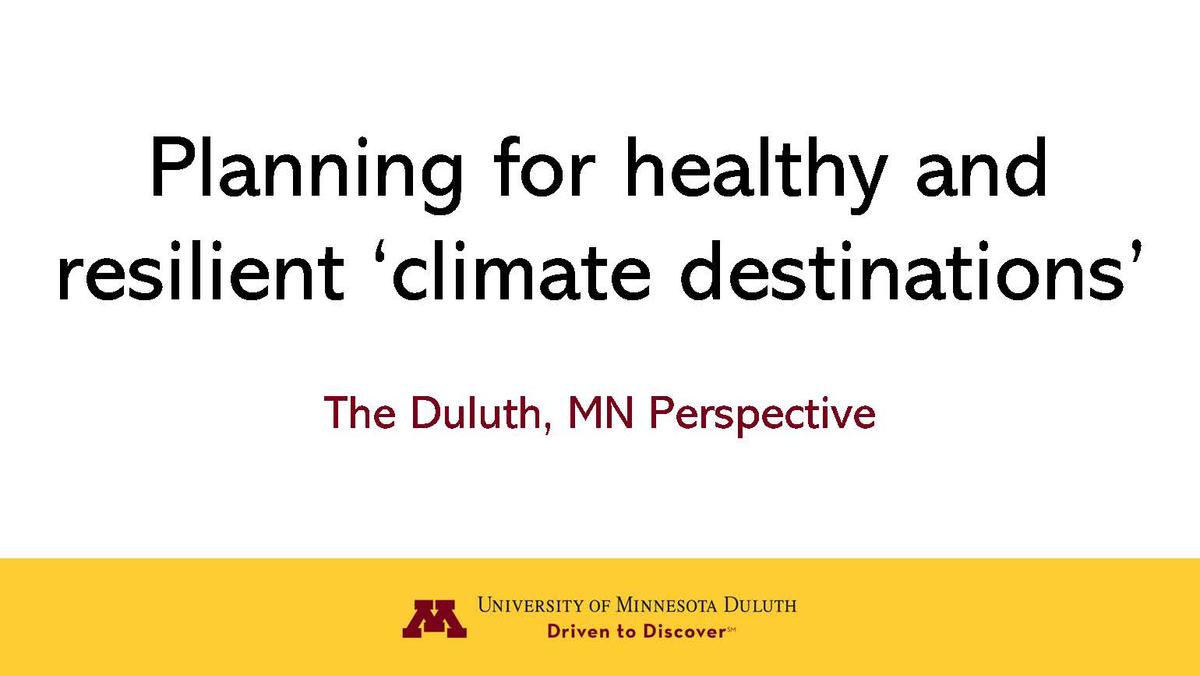The Bureau of Business and Economic Research at the University of Minnesota Duluth (UMD) is part of a national professional organization—the Association for University Business and Economic Research (AUBER). There are more than 75 AUBER members throughout the country. Most are university research bureaus (like the BBER), but AUBER members also include private consulting firms, government entities, and economists. AUBER supports its members through a variety of ways. But without a doubt, the most valuable benefit of being an AUBER member is the organization’s annual conference.
Last week I had the opportunity to present at the AUBER conference in Pensacola, Florida. My presentation was on the research I conducted last year with UMD Health Care Management faculty Dr. Kim Dauner, which focused on climate migration from the perspective of a so-called climate haven or climate refuge city—Duluth, Minnesota. A show of hands at the beginning of the presentation suggested that many of the attendees were concerned about the future impacts of climate change on their own city’s population.
Below are some of the key points of my presentation and implications for cities across the country. Check out the full presentation here.
Duluth is slightly ahead of the game, in part because the media woke us up to discussing resiliency at a local level.
In March 2019, Jesse Keenan (then professor in the Graduate School of Design at Harvard University) came to Duluth and gave a presentation titled “Duluth: The most climate proof city in America.” Keenan suggested the city market itself to people relocating from climate-impacted regions, citing Duluth’s cool climate, inland location, and access to fresh water as factors that make it more resilient to the future impacts of climate change. His visit, and a corresponding New York Times article, set off an outpouring of media attention. If you do a google news search today for the terms “Duluth MN climate migration,” you will find more than 1,300 hits.
While it’s true that Duluth’s natural amenities may make it more resilient to the future impacts of climate change, I would argue that the media frenzy also gave the city an advantage in that it elevated conversations about climate change and resiliency locally. The city of Duluth’s administration has done a significant amount of work related to sustainability and resiliency in recent years, completing a climate vulnerability study in 2017, hiring a sustainability officer in 2020, and publishing its climate action work plan earlier this year. But Keenan’s presentation and the corresponding media attention has raised public awareness of the topic throughout the city.
Natural amenities alone are not enough to make a city resilient to the impacts of climate change.
Much of the media attention about Duluth as a climate refuge has focused primarily on the city’s location on Lake Superior and its cool summers. But our research found that natural resources are not the only factor that is important for cities to consider when planning for the impacts of climate change.
Recently the BBER wrote an article about the U.S. Census Bureau’s community resilience dataset. Community resilience is the capacity of individuals and households within a community to absorb the external stresses of a disaster, such as a hurricane, fire, or flood. The Census Bureau’s tool uses measures such as poverty, disability, health insurance, broadband access, and communication barriers to measure community resilience. Similarly, the individuals the BBER interviewed for our research project mentioned factors such as equity, social capital, and housing as being equally as important to becoming a resilient community.
Resiliency is not a trait, it’s an approach.
The term “climate destination” was coined by a 2021 study by researchers Marandi and Main. Their study identified three types of U.S. cities affected by climate migration: Vulnerable cities, recipient cities, and climate destinations. Vulnerable cities are those likely to be most negatively impacted by the hazards of climate change (population loss). Recipient cities are those that are most likely to receive large numbers of migrants due to sudden-onset disasters. Climate destinations have the following characteristics in common: (1) ready access to fresh water supply; (2) more manageable climate impacts; (3) post-industrial, legacy cities with high infrastructural capacity; (4) high vacancy rates or an abundance of affordable housing; (5) an expressed desire to grow and be welcoming; and (6) history of or interest in sustainability or resilience efforts.
While all six of these traits are important, I would argue that cities which possess traits one through five but do not take steps toward building resilience to climate change will be at a significant disadvantage to those that are actively working on sustainability or resiliency efforts, regardless of how they fare on the other traits. In the worst-case scenario, a city that has not planned for the potential impacts of climate migration may end up becoming a vulnerable or receiving city and be completely unprepared for rapid changes in population.
Luckily, there are resources available to help cities prepare. A recent study by the American Society of Adaptation Professionals (ASAP), titled “Climate and Demographic Change in the Great Lakes,” highlighted research and policy agendas that may help Great Lakes states prepare for, if not thrive within, future climate and demographic conditions. Similarly, a 2013 study titled “Health in All Policies: A Guide for State and Local Governments” is a useful resource for communities thinking about resiliency from a public health standpoint.
Migration patterns tend to follow historical trends. Until they don’t.
One of the central questions in our research was, “If Duluth is a climate destination, are people actually moving here?” What we found was that, anecdotally, there is a sense that migration is happening. Nearly everyone we interviewed knew at least one person who had moved to Duluth in part due to concerns about climate change. Since 1990, however, the city’s population has grown very little, suggesting that the current numbers of climate migrants are not changing the trajectory of the city’s population much if at all.
What’s more, some of the cities that have grown the fastest in the past twenty years nationally include cities like Las Vegas, Phoenix, and Austin, many of which are experiencing significant increases in the number of “very hot days” per year, wildfires, water shortages, or other climate concerns. For the most part, extreme weather events (and heat) are not yet factoring into most people’s decisions about where to live or raise their families, despite the risks.
Some literature has attempted to quantify future changes in population resulting from climate change. Most of that literature suggests very small changes in Duluth’s population. For example, a 2020 study by Robinson, Dilkina, and Moreno-Cruz predicted 1,000 to 10,000 new net migrations in St. Louis County by 2100. Or less than 0.5% increase over the current population.
Yet there are some major caveats to this type of research. Most of the studies that attempted to quantify population changes in any way tended to focus on sea-level rise only, and those studies were based almost entirely on historical migration patterns. Meaning, they assumed increased migration would happen almost entirely in neighboring communities. Those assumptions don’t consider perceptions of destination cities or the policy, social, and economic factors that might be influencing people’s migration patterns in the face of increased pressure due to climate change.
Many of the AUBER conference attendees shared that my presentation resonated with them and that the findings provided information they could take back to their communities. Maybe some of these takeaways will help policymakers and planners as well. There is a great need for additional research in this area, and I hope that Dr. Dauner and I can continue to examine the topic of climate resilience and migration patterns in the future.

